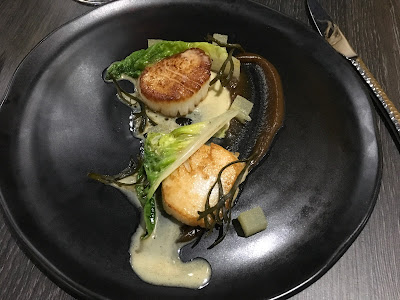The Ploughman’s lunch. Served on a board in a 15th century pub which is dog friendly so that there’s a black labrador sitting in the hearth (fire unlit, it’s a relatively warm day for January). The photograph of it is so pretty and colourful it could be some artist’s still life effort.
Much is written about the ploughman’s lunch. It’s an English and, so they say, recently invented little pleasure that conjures up pastoral music, think Vaughan Williams (my music knowledge is weak but Vaughan Williams sounds like the right sort of name for this occasion). Though they also say the English rural working man, including ploughmen, would have been eating it back in medieval times, well the cheese and bread bit anyway. They say that though the cheese and bread reality had existed for centuries someone clever in the ‘Cheese Bureau’ (yes, really) put it together in the late 1950s to promote the sale of English cheese after the end of rationing and it was felt that calling it something catchy like ‘Ploughman’s lunch’ would rekindle the flame of English cheese consumption.
The Milk Marketing Board really got things moving in the early 1960s with its Ploughman’s Lunch promotion and I remember my very first, and what seemed wondrous, Ploughman’s lunch consumed outside the Old Hare and Hounds at the Lickey Hills not far from where I lived as a boy (and still do) with my father somewhere around 1962 or 63. To accompany it he drank half a pint of mild and I quenched my thirst with Vimto. Our discovery of the Ploughman’s lunch, albeit in so modest a form that it would be more easily recognised by a medieval agricultural labourer than a modern day pub luncher, set us on a road of father-son bonding over a weekly home-made Ploughman’s whilst watching the weekly episode of The High Chaperral on Saturday-evening BBC television. The Old Hare and Hounds Ploughman’s, which we copied, was simply a wonderfully crusty roll of bread with butter, tasty Cheddar cheese and rings of hot but sweet Spanish onion. Hmmm .... the sheer joy of delicious simplicity.
Which brings me back to the 15th century (more specifically 1470) dog-friendly pub mentioned above where the subject of the Ploughman’s Lunch cropped up - the Old Thatch Tavern in Stratford-upon-Avon (the dog and I were passing a couple of lazy days in this gem of a West Midlands towns). Wanting a light lunch as I was going to dinner at The Woodsman (see Blog 57) in the evening I scanned the menu and was overcome by an overwhelming Ploughman’s Lunch desire. And what a magnificent piece of work was set before me - 2 good-sized wedges of what I took to be fine Red Leicester, an array of pickles (a pleasant Branston, a really rather good pickled egg but a brutally astringent large, halved pickled onion which had an unsweetened acidity rendering it beyond edibility and which could quite happily have been substituted by some sweet little silverskin pickled onions), a sadly near-flavourless mini-pork pie, a pretty little salad wherein lay the necessary slivers of red onion, the surprising but picturesque little bunch of grapes and what really made this a fine Ploughman's - two thick cuts of splendid ham as tasty a ham as one might ever encounter on the road of food pleasure.
It was a great pleasure to sit in these ancient and cosy surroundings and eat this generally tasty version of a dish that the Stratford labourers might have been eating when this inn was first built and if a tastier pork pie could be found - I like a pork pie rendered more vigorous with the hit of pepperiness - and the aggressive pickled onion could be substituted then this would be an even grander Ploughman’s Lunch.
As an afterthought I recall that the Ploughman’s Lunch is one of the few foods or dishes to gives its name to the title of a movie (others I can think of are Disney’s Ratatouille and Woody Allen’s Bananas). A movie of the 1980s by Richard Eyre was named after the dish and proved to be one of the great movies of that decade reflecting perfectly the England of the era of Margaret Thatcher.
As a further afterthought I’ve decided that I’m going to make 2020 my Year Of The West Midlands Ploughman’s Lunch and have resolved to eat a Ploughman’s Lunch in any establishment in which I’m eating which is offering the dish and which looks like something fine is going to be served up to me. To compare I shall, unusually, give ratings so to start off I give the Old Thatch Tavern Ploughman’s a 7 out of 10 which is a pretty good score, just let down by the pork pie and the vaguely rebarbative pickled onion but strongly boosted by the delicious ham and the very pretty picture it makes when first served.






















